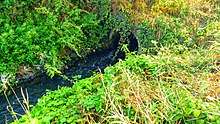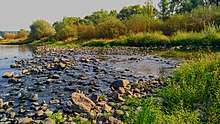Wastewater treatment
.jpg)
Wastewater treatment is a process used to convert wastewater into an effluent that can be returned to the water cycle with minimum impact on the environment, or directly reused. The latter is called water reclamation because treated wastewater can then be used for other purposes. The treatment process takes place in a wastewater treatment plant (WWTP), often referred to as a Water Resource Recovery Facility (WRRF) or a sewage treatment plant. Pollutants in municipal wastewater (households and small industries) are removed or broken down.
The treatment of wastewater is part of the overarching field of sanitation. Sanitation also includes the management of human waste and solid waste as well as stormwater (drainage) management.[1] By-products from wastewater treatment plants, such as screenings, grit and sewage sludge may also be treated in a wastewater treatment plant.[2]:Ch.14
Disposal or reuse
Although disposal or reuse occurs after treatment, it must be considered first. Since disposal or reuse are the objectives of wastewater treatment, disposal or reuse options are the basis for treatment decisions. Acceptable impurity concentrations may vary with the type of use or location of disposal. Transportation costs often make acceptable impurity concentrations dependent upon location of disposal, but expensive treatment requirements may encourage selection of a disposal location on the basis of impurity concentrations. Ocean disposal is subject to international treaty requirements. International treaties may also regulate disposal into rivers crossing international borders. Water bodies entirely within the jurisdiction of a single nation may be subject to regulations of multiple local governments. Acceptable impurity concentrations may vary widely among different jurisdictions for disposal of wastewater to evaporation ponds, infiltration basins, or injection wells.
Processes used
Phase separation

Phase separation transfers impurities into a non-aqueous phase. Phase separation may occur at intermediate points in a treatment sequence to remove solids generated during oxidation or polishing. Grease and oil may be recovered for fuel or saponification. Solids often require dewatering of sludge in a wastewater treatment plant. Disposal options for dried solids vary with the type and concentration of impurities removed from water.
Production of waste brine, however, may discourage wastewater treatment removing dissolved inorganic solids from water by methods like ion exchange, reverse osmosis, and distillation.
.jpg)
Sedimentation
Solids and non-polar liquids may be removed from wastewater by gravity when density differences are sufficient to overcome dispersion by turbulence. Gravity separation of solids is the primary treatment of sewage, where the unit process is called "primary settling tanks" or "primary sedimentation tanks". It is also widely used for the treatment of other wastewaters. Solids that are heavier than water will accumulate at the bottom of quiescent settling basins. More complex clarifiers also have skimmers to simultaneously remove floating grease like soap scum and solids like feathers or wood chips. Containers like the API oil-water separator are specifically designed to separate non-polar liquids.[3]
Filtration
Colloidal suspensions of fine solids may be removed by filtration through fine physical barriers distinguished from coarser screens or sieves by the ability to remove particles smaller than the openings through which the water passes. Other types of water filters remove impurities by chemical or biological processes described below.[4]
Oxidation
Oxidation reduces the biochemical oxygen demand of wastewater, and may reduce the toxicity of some impurities. Secondary treatment converts organic compounds into carbon dioxide, water, and biosolids. Chemical oxidation is widely used for disinfection.
.jpg)
Biochemical oxidation
Secondary treatment by biochemical oxidation of dissolved and colloidal organic compounds is widely used in sewage treatment and is applicable to some agricultural and industrial wastewaters. Biological oxidation will preferentially remove organic compounds useful as a food supply for the treatment ecosystem. Concentration of some less digestible compounds may be reduced by co-metabolism. Removal efficiency is limited by the minimum food concentration required to sustain the treatment ecosystem.[5]
Chemical oxidation
Chemical oxidation may remove some persistent organic pollutants and concentrations remaining after biochemical oxidation.[6] Disinfection by chemical oxidation kills bacteria and microbial pathogens by adding ozone, chlorine or hypochlorite to wastewater.[2]:1220
Polishing
Polishing refers to treatments made following the above methods. These treatments may also be used independently for some industrial wastewater. Chemical reduction or pH adjustment minimizes chemical reactivity of wastewater following chemical oxidation.[7] Carbon filtering removes remaining contaminants and impurities by chemical absorption onto activated carbon.[2]:1138 Filtration through sand (calcium carbonate) or fabric filters is the most common method used in municipal wastewater treatment.
Wastewater treatment plants
Wastewater treatment plants may be distinguished by the type of wastewater to be treated, i.e. whether it is sewage, industrial wastewater, agricultural wastewater or leachate.

Sewage treatment plants
A typical municipal sewage treatment plant in an industrialized country may include primary treatment to remove solid material, secondary treatment to digest dissolved and suspended organic material as well as the nutrients nitrogen and phosphorus, and – sometimes but not always – disinfection to kill pathogenic bacteria. The sewage sludge that is produced in sewage treatment plants undergoes sludge treatment. Larger municipalities often include factories discharging industrial wastewater into the municipal sewer system. The term "sewage treatment plant" is now often replaced with the term "wastewater treatment plant".[2] Sewage can also be treated by processes using "Nature-based solutions".
Tertiary treatment
Tertiary treatment is a term applied to polishing methods used following a traditional sewage treatment sequence. Tertiary treatment is being increasingly applied in industrialized countries and most common technologies are micro filtration or synthetic membranes. After membrane filtration, the treated wastewater is nearly indistinguishable from waters of natural origin of drinking quality (without its minerals). Nitrates can be removed from wastewater by natural processes in wetlands but also via microbial denitrification. Ozone wastewater treatment is also growing in popularity, and requires the use of an ozone generator, which decontaminates the water as ozone bubbles percolate through the tank, but this treatment is energy intensive. The latest, and very promising treatment technology is the use aerobic granulation.
Industrial wastewater treatment plants


Disposal of wastewaters from an industrial plant is a difficult and costly problem. Most petroleum refineries, chemical and petrochemical plants[8][2]:1412 have onsite facilities to treat their wastewaters so that the pollutant concentrations in the treated wastewater comply with the local and/or national regulations regarding disposal of wastewaters into community treatment plants or into rivers, lakes or oceans. Constructed wetlands are being used in an increasing number of cases as they provided high quality and productive on-site treatment. Other industrial processes that produce a lot of waste-waters such as paper and pulp production has created environmental concern, leading to development of processes to recycle water use within plants before they have to be cleaned and disposed.[9]
Industrial wastewater treatment plants are required where municipal sewage treatment plants are unavailable or cannot adequately treat specific industrial wastewaters. Industrial wastewater plants may reduce raw water costs by converting selected wastewaters to reclaimed water used for different purposes. Industrial wastewater treatment plants may reduce wastewater treatment charges collected by municipal sewage treatment plants by pre-treating wastewaters to reduce concentrations of pollutants measured to determine user fees.[10]
Although economies of scale may favor use of a large municipal sewage treatment plant for disposal of small volumes of industrial wastewater, industrial wastewater treatment and disposal may be less expensive than correctly apportioned costs for larger volumes of industrial wastewater not requiring the conventional sewage treatment sequence of a small municipal sewage treatment plant.[11]
An industrial wastewater treatment plant may include one or more of the following rather than the conventional primary, secondary, and disinfection sequence of sewage treatment:
- An API oil-water separator, for removing separate phase oil from wastewater.[12]
- A clarifier, for removing solids from wastewater.[13]
- A roughing filter, to reduce the biochemical oxygen demand of wastewater.[14]
- A carbon filtration plant, to remove toxic dissolved organic compounds from wastewater.[15]
- An advanced electrodialysis reversal (EDR) system with ion exchange membranes.
Agricultural wastewater treatment plants
Agricultural wastewater treatment for continuous confined animal operations like milk and egg production may be performed in plants using mechanized treatment units similar to those described under industrial wastewater; but where land is available for ponds, settling basins and facultative lagoons may have lower operational costs for seasonal use conditions from breeding or harvest cycles.[16]
Leachate treatment plants
Leachate treatment plants are used to treat leachate from landfills. Treatment options include: biological treatment, mechanical treatment by ultrafiltration, treatment with active carbon filters and reverse osmosis using disc tube module technology.
See also
References
- ↑ "Sanitation". Health topics. World Health Organization.
- 1 2 3 4 5 Metcalf & Eddy, Inc. (2003). Wastewater Engineering: Treatment and Reuse (4th ed.). New York: McGraw-Hill. ISBN 0-07-112250-8.
- ↑ Weber, pp.111-138
- ↑ Weber, pp.139-196
- ↑ Steel & McGhee, pp. 477–521
- ↑ Weber, pp.363-408
- ↑ Weber, p.439
- ↑ Beychok, Milton R. (1967). Aqueous Wastes from Petroleum and Petrochemical Plants (1st ed.). John Wiley & Sons. LCCN 67019834.
- ↑ Byrd, J.F.; Ehrke, M.D.; Whitfield, J.I. (April 1984). "New Bleached Kraft Pulp Plant in Georgia: State of the Art Environmental Control". Journal (Water Pollution Control Federation). 56 (4): 378–385. JSTOR 25042250. .
- ↑ Hammer, pp.300-302
- ↑ Kemmer, pp.40-4-40-11
- ↑ Patterson, p.180
- ↑ Kemmer, p.41-15
- ↑ Kemmer, p.23-11
- ↑ Patterson, p.210
- ↑ Reed, Middlebrooks & Crites, pp.6-8
Sources
- Hammer, Mark J. (1975). Water and Waste-Water Technology. New York: John Wiley & Sons. ISBN 0-471-34726-4.
- Kemmer, Frank N. (1979). The Nalco Water Handbook. New York: McGraw-Hill Book Company.
- Patterson, James W. (1980). Wastewater Treatment Technology. Ann Arbor, Michigan: Ann Arbor Science. ISBN 0-250-40086-3.
- Ramseur, Jonathan L. (September 22, 2017). Wastewater Infrastructure: Overview, Funding, and Legislative Developments (PDF). Washington, DC: Congressional Research Service. Retrieved 17 December 2017.
- Reed, Sherwood C.; Middlebrooks, E. Joe; Crites, Ronald W. (1988). Natural Systems for Waste Management and Treatment. New York: McGraw-Hill Book Company. ISBN 0-07-051521-2.
- Weber, Walter J., Jr. (1972). Physicochemical Processes for Water Quality Control. New York: Wiley-Interscience. ISBN 0-471-92435-0.